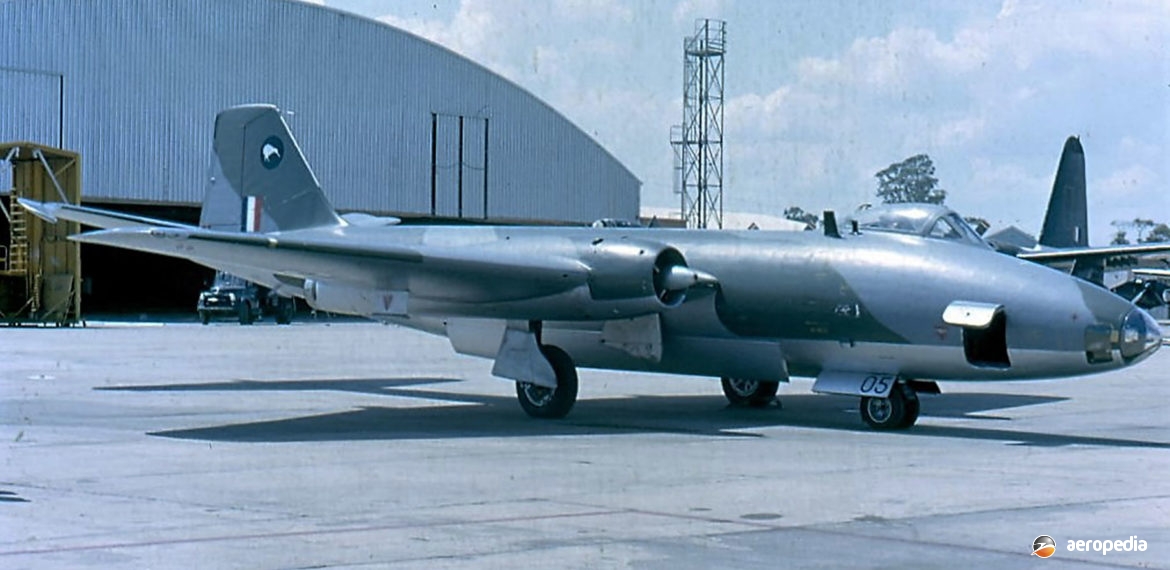Photograph:
RNZAF English Electric Canberra B (I) Mk 12 NZ6105 (c/n 71658) at RAAF Richmond, NSW in 1988 (David C Eyre)
Country of origin:
United Kingdom
Description:
Long-range interdiction / tactical bomber
Power Plant:
Two 7,400 lbst Rolls Royce Avon RA.7 Mk 109 turbojets
Specifications:
- Wingspan: 19.5 m (63 ft 11½ in)
- Length: 19.96 m (65 ft 6 in)
- Height: 4.77 m (15 ft 8 in)
- Wing area: 89.19 m² (960 sq ft)
- Max speed at 12,190 m 871 km/h: (541 mph)
- Max speed at sea level 832 km/h: (517 mph)
- Max rate of climb: 1,036 m/min (3,400 ft/min)
- Service ceiling: 14,630 m (48,000 ft)
- Ferry range: 5,842 km (3,630 miles)
- Combat range: 1,297 km (806 miles)
- Internal fuel: 11,170 litres (2,457 miles)
- Range extended by two: 1,109 litre (244 Imp gal) wingtip tanks
- Empty weight: 12,678 kg (27,950 lb)
- Max take-off weight: 24,925 kg (54,950 lb)
Armament:
Pack of four 20 mm Hispano cannon in bomb bay
History:
As noted elsewhere, the English Electric Canberra was Britain’s first jet bomber and was exported to a number of operators, being licence built in the United States of America and Australia.
The prototype made its first flight on 13 May 1949 and was fitted with Avon Mk 101 engines. Various models were built for training, bombing, photo reconnaissance and interdiction, the first of the latter being the B (I) Mk 8 which was based on the B Mk 6 but had a new nose with the pilot sitting under a fighter-type canopy offset to port. This model was exported as the B (I) Mk 12, B (I) Mk 58, B (I) Mk 68 and B (I) Mk 88. The T Mk 4 was also exported and variants of this became the T Mk 13, T Mk 21, T Mk 64 and T Mk 84.
The B (I) Mk 8 was developed in 1954, the prototype (VX185) was first flying in January 1956 and being supplied to Nos 86, 59 and 16 Squadrons Royal Air Force (RAF), being used in the low-level environment, including close-air support and strike duties, eventually being fitted with Matra rocket pods under the wings. RAF units were involved in the Kuwait crisis in 1961 and the Indonesian confrontation in 1965.
In 1959 an order was placed for eleven B (I) Mk 12 Canberras (serials NZ6101 to NZ6111), and this was increased with two further Canberras on 28 October 1959. The Canberras joined the newly formed Bomber Operational Conversion Unit. Thereafter the Canberras were operated by No 14 Squadron and regularly visited areas in the Pacific for operational exercises, in 1965 being based in Singapore.
First operation of the type was a strike on 30 September 1958 when three aircraft dropped eighteen 454 kg (1,000 lb) bombs from 3,658 m (12,000 ft). The unit continued with South East Asia Treaty Organisation (SEATO) exercises in The Philippines and Thailand, and further operations continued during the Malayan Emergency.
The Canberras initially followed British practice and between 1959 and 1964 were overall silver with black serial numbers, but were later camouflaged and had white serials.
Two were lost in service NZ6101 (c/n 71443 – ex WT329) and NZ6104 (c/n 71657).
Ten of the survivors were sold to the Indian Air Force in 1970: NZ6102 (c/n 71642), NZ6103 (c/n 71656), NZ6105 (c/n 71658), NZ6107 (c/n 71660), NZ6108 (c/n 71661), NZ6109 (c/n 71662), NZ6110 (c/n 71671) and NZ6111 (c/n 71699). One NZ6106 (c/n 71659) was sold to the British Aircraft Corporation.
It is interesting to note that during the Vietnam War consideration was given to deploying some RNZAF Canberras or aircrew to Vietnam. This scheme was given consideration in the New Zealand capital, Wellington, in August 1965. At that time the American Martin B-57 Canberras were being used in the fighter-bomber and air-to-ground role and were capable of delivering munitions in this role; whereas the Australian Canberra could only be used in the level flight bombing role.
The RNZAF Canberra, being the B (I) Mk 12 model, was technically closer to the role of the American Martin B-57 Canberra and was aimed at the interdiction / close support role and using similar weaponry. However, it was thought New Zealand could not in the circumstances of deployment to Vietnam meet its commitment to the Commonwealth Strategic Reserve and this plan did not proceed.
By October 1966 consideration was given to 45 to 50 personnel being attached as a separate flight as part of one of the American Martin B-57 Canberra units and operating that type but because of the differences between the two aircraft types it would have required a lot of retraining and this idea was also shelved.
One B (I) Mk 8 WT346 (c/n 71506 – ex Instructional Airframe 8197M) has been placed on display at the RNZAF Museum at Wigram. This aircraft was obtained from the United Kingdom and has been painted as an RNZAF B (I) Mk 12 Canberra for the museum.

